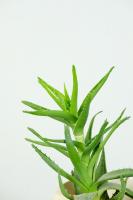Introduction
Palm trees are a common sight in tropical and subtropical regions, providing shade, beauty, and a source of food and materials for local communities. They can be found in both natural landscapes and cultivated environments, and come in a variety of shapes, sizes, and colors. But what kind of plant is a palm tree exactly, and what are its defining characteristics? In this article, we will explore the anatomy, biology, and ecology of one of the world's most recognizable tree species.
Overview of Palm Trees
Palm trees belong to the family Arecaceae, which contains over 2,600 species that are distributed all over the world. They are part of the monocotyledon group, which means that they have a single embryonic leaf when they sprout from a seed. Unlike most other plants, palm trees do not have branches but instead grow from a single stem called a trunk. This trunk is usually tall and cylindrical, with a smooth surface covered in leaf scars from old fronds. Palm trees also have long, feathery leaves called fronds that are arranged in a spiral pattern at the top of the trunk. These fronds can range in color from green to silvery-gray and can be either pinnate (divided into smaller leaflets) or palmate (shaped like a fan).
Types of Palm Trees
There are hundreds of different species of palm trees, each with its own unique set of traits and characteristics. Some of the most well-known types of palm trees include:
Coconut palm (Cocos nucifera): known for its large, round fruit that is used for food and drink
Date palm (Phoenix dactylifera): known for its sweet, sticky fruit that is a staple food in the Middle East and North Africa
Areca palm (Dypsis lutescens): known for its slender trunk and delicate fronds, often used as a decorative indoor plant
Palmetto palm (Sabal palmetto): known for its fan-shaped fronds and ability to tolerate salt spray and sandy soils, often used in coastal landscapes
Oil palm (Elaeis guineensis): known for its high-yielding oil that is used in a variety of foods and products
Anatomy of Palm Trees
Palm trees have a unique anatomy compared to other types of plants. Their stems are composed of a thick, fibrous layer called the trunk, which is made up of vascular tissue that transports nutrients and water throughout the tree. The trunk is covered in a layer of bark that protects the inner tissue from damage and disease. At the top of the trunk are the fronds, which are the main photosynthetic organs of the tree. These fronds contain a network of veins that transport water and nutrients between the roots and the top of the tree. The roots of palm trees are also unique in that they grow from a specialized structure called the basal plate, which is located at the base of the trunk. This allows the tree to anchor itself firmly in the soil and absorb nutrients and water from a wide area.
Ecology of Palm Trees
Palm trees are an important component of many tropical and subtropical ecosystems. They provide food, shelter, and habitat for a wide range of animals, including birds, insects, and small mammals. They also help to stabilize sandy soils and prevent erosion, particularly in coastal areas. Many communities around the world also rely on palm trees for their livelihoods, whether for food, fiber, or building materials. However, the cultivation of large plantations of palm trees for commercial purposes has also led to significant environmental challenges, including deforestation, habitat loss, and biodiversity loss. To ensure the long-term sustainability of palm tree ecosystems, it is important to balance economic development with conservation efforts and targeted management practices.
Conclusion
In conclusion, palm trees are an incredibly diverse and fascinating group of plants that play an important role in many different ecosystems and human communities around the world. Whether we are admiring their beauty, enjoying their fruit, or using their fibers to build our homes, palm trees will continue to be a valuable resource and a symbol of tropical life for generations to come.

 how many times do yo...
how many times do yo... how many planted tre...
how many planted tre... how many pine trees ...
how many pine trees ... how many pecan trees...
how many pecan trees... how many plants comp...
how many plants comp... how many plants can ...
how many plants can ... how many plants and ...
how many plants and ... how many pepper plan...
how many pepper plan...

































